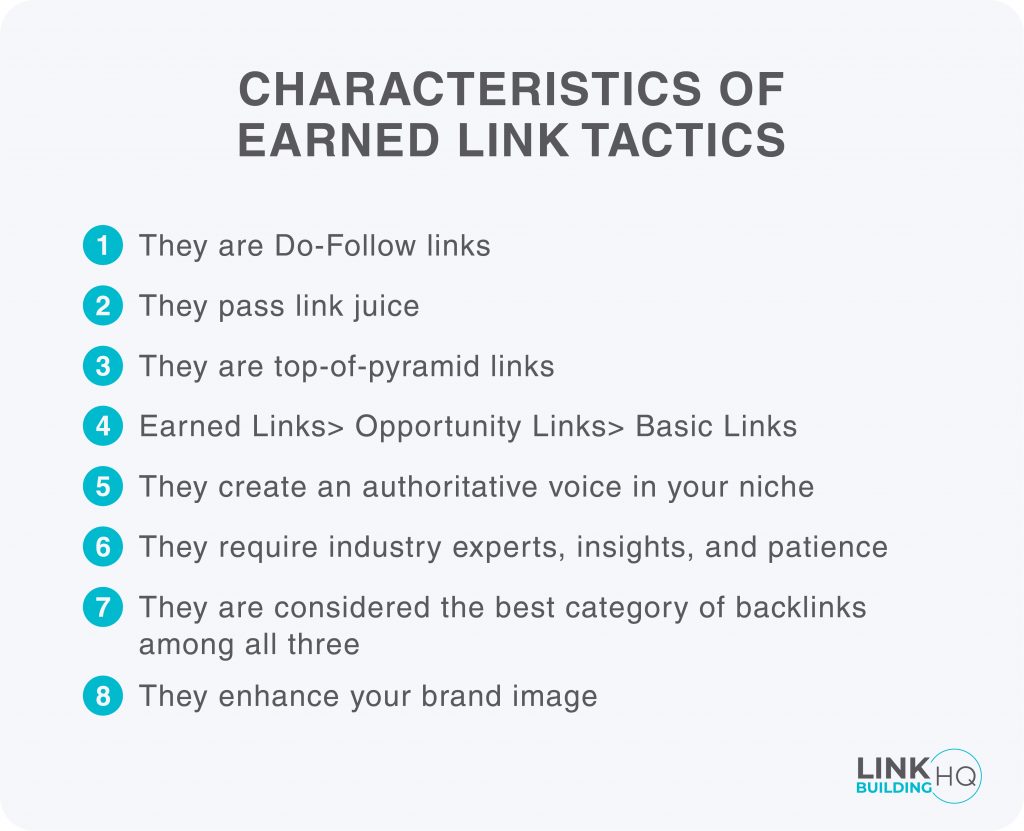Chapter 6: Top 5 Reward Backlink Tactics for High-Quality Backlinks
Reward links are a kind of link that you can earn by creating content so apt that readers can’t hold themselves back from sharing. it
Reward Links
The Reward link strategy (AKA Linkbait content strategy) involves receiving high-quality backlinks based on your unique and valuable content. To achieve these pyramid-top backlinks, you need an excellent content strategy.
Let us first review all the characteristics of Reward Links.
Although these links depend upon the excellence of your content, there are some tactics that you can incorporate to make your content link-worthy.
The 3 best Reward link tactics are:
1. E-Books/Manuals/Guides:
Ebooks, manuals, or guides are usually the longest forms of content. Long-form content displays authority not just for the user but also for the algorithm. If you become an authority on a subject, whether by extensive research or great ideas, other websites will start quoting you. In other words, they will mention you with a backlink.
One of the ways to get ahead is often via how-to guides and instruction manuals. With technology changing every day, people are often looking for assistance via such guides and manuals. Through your content, they find the solution to their problem and in return, you get the desired traffic.
In essence, it is one of the best ways to garner attention and of course, get lots of backlinks.
Regardless of the industry, these guides always come in handy for your Target Audience. If you are wondering how you can write an effective How-To guide, here are 3 easy steps:
1. Research, Research, and Research:
Unless you understand your audience, competitors, and product thoroughly, you cannot create a comprehensive guide.
Start with understanding your audience. For example, What is their age group, which generation do they belong to, what are their interests, where do they live, what activities do they do in a week, and other such details.
Then, probe into what your competitors are doing. What kind of content are they producing, are readers liking the content, what is their strategy like, what are the gaps that you can fill in, and are they getting backlinks on their content?
Lastly, research the product that you own. For instance, you can make a checklist of questions:
- How are people talking about it?
- What are the pain points of the users?
- How are other brands catering to the problems?
- What are the areas that you can tap into?
- How can your guide contribute towards solving a problem?
2. An Ideal Title
The first thing that needs to grab user attention is your “Title.” This is the point where you want your user to leave everything else and read your guide. So, make sure your title is engaging, interesting, and relevant.
Below are the types of titles that you can use for your guides or manuals.
1. Question Title:
Ask a question in your title that would instantly catch their eye.
Example:
- How to survive in a toxic workplace, a guide.
- How to make excellent PowerPoint presentations? (Video Tutorial)
2. Informative Titles
Titles that assist readers in understanding what the guide revolves around.
Example:
- 5 Excel formulas that can change everything.
- Storytelling for a high-converting landing page.
- SEO for small business owners.
3. Quirky Titles:
A little bit of rhyming, some wordplay, and a pinch of humor can never go out of style when it comes to titles.
3. Simplicity is the key
Keep the structure and language of your guide as simple as possible. Experts suggest that your content should be written in a manner that even a 10-year-old can easily comprehend.
Do remember that people need guides and manuals because they are unable to understand how to use a particular product. Hence, it is your responsibility to explain all the steps in the easiest way possible, using the simplest vocab and structure. The more understandable your guide, the more reward links you gain.
Here are some tips that you can incorporate in your writing:
- Use smaller sentences.
- Use the easiest vocabulary possible.
- Use active voice (Subject+Verb+Object).
- Use transitional verbs. Here is a list of all the transitional verbs.
2. Infographics
According to research, people are able to retain only 10% of the information if they read it. But interestingly, if they consume the same information via visuals, they are likely to remember 65% of it even after 3 or more days.
Moreover, we live in a fast-paced, digital world where nobody has enough time to read multiple long pages. Also, people need fast but accurate information.
Solution? Infographics.
Infographics are visually represented information, data, or other knowledge that is accurate, short, and easy to understand. Since the medium is more aesthetic and engaging, it has the potential to attract many reward links.
There are many apps out there that can help you make infographics in a very efficient manner. One such app is:
Canva
One of the most convenient and easy-to-use apps that has 10000+ templates for free. You can even choose the medium you want to post that infographic on, for example, Facebook or Quora, and Canva would even customize the size of the image for you.
3. Surveys, Studies & Polls
Surveys and polls can give you the required fame, popularity, and consequently, backlinks. Surveys are usually original pieces of research that you have done. If the results are impactful and confirm an idea, you are more likely to get referred. There are two ways you can show research results.
1. Research Study
As the name suggests, ‘Do Your Own Research means to actually conduct research. This is the best way to generate unique content and turn all the heads your way. Many bloggers, journalists, and marketers wait for new updates and research, which they can use to validate their statements, opinions, or their even own research.
You can conduct your own research in 4 easy steps.
i. Identify Research Gap:
To do so, you can use:
- Google Trends
- Buzzsumo
Then, you can analyze the topics that are trending and the type of content your competitors are producing. This will give you a direction you can further dig in and come up with a research gap/problem.
ii. Write Objectives:
All the things that you are trying to achieve with this research will come under research objectives. For example:
- Explore what kind of content people like to see on Facebook
- Investigate which social media platform is loved by your audience.
iii. Data Collection
Now, you can evaluate all the available techniques for data collection and then choose the most appropriate one according to your research. The most common available techniques are
- HARO (help a reporter out)
- Polls on Socials (Facebook, Instagram, etc)
- Google Forms
- Focus Groups
iv. Analysis and Report
Now analyze the result and make a report with the help of charts and graphs. You are all set to publish.
2. Research Paper
A research paper refers to quoting, summarizing, analyzing, and concluding multiple pieces of research in one place.
It utilizes secondary research that you can convert into engaging visuals and gain backlinks.
4. News, Updates, and Analysis
Be the first one to break the news related to your industry, and you could get all the virality along with reward links, too. To become people’s number-one choice for any news or updates, you have to follow all the sources of information.
This could work better for trending topics or news websites. However, an analysis piece could work in any industry. If you are a subject matter expert, people would want to hear from you and could quote you.
For example, if you are in the SEO industry, you have to follow all the official sources of Google. Be it their website, Twitter account, Facebook account, or so on. You may also follow @searchenginejournal and @searchengineland for the latest updates and news.
Try to follow news and trending topics in your niche, and be open to difficult questions. Many would not be able to answer, but if you spend time writing from different angles or be the first one to write, you are more likely to build authority and backlinks.
5. Case Studies
Case studies usually start with a problem, moving on to an action plan, and then a solution or results provided by those actions. It could be about someone in the industry or your own solution.
Most businesses look for such results that could also help them out. A complete case study on how a product or service resolved a problem for someone could be goldmine content for others.
As content becomes more sharable and linkable, it provides more value.
Takeaway
Quality content that is unique, provides value, and solves users’ problems will become an asset and will keep giving you dividends in the form of backlinks, shares, and authority. There is already a ton of content on the internet, and more is being published every year. Content that stands out is one that takes the effort to make it more valuable through insights, better writing, and visual representation.
You are equipped with all the top tactics to create high-quality backlinks and a robust link building profile. But in order for them to impact your rankings, you need to make sure your house is linked, too. The next chapter is about how internal linking, or links between your website, helps Google understand the structure of your content.
Further Readings
- All You Need To Know About YMYL (Your Money Your Life)
- What’s The Difference Between Content Marketing And Link Building?
- My Content Will Not Rank If It’s Not Fresh
- Is Guest Posting The Only Way To Build Links?
- Myth: Links On High PR (PageRank) Sites Are The Only Ones That Matter
- Myth: External Links Matter More Than Internal Ones
- How Do You Decide What Keywords To Put In My Blog?
- How Good Is The Quality Of Your Content?
- Content Consumption Trends For 2022 (Survey Insights)
- Content Marketing: A Simple Guide For 2021
- 5 Copywriting Tips For Better SEO
- How To Perform A Successful Content Audit: The Ultimate Guide
- How To Build Links In Difficult Niches?
- How Effective Content Marketing Can Attract High-Quality Links



